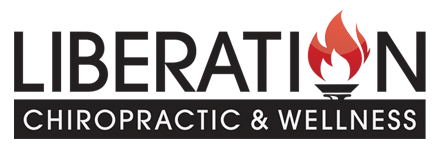Dr. Jordan Moore / December 15, 2019 / Exercise, Chiropractic, Science & Technology

In this workshop event Dr. Jordan Moore of Liberation Chiropractic & Wellness in Mobile Alabama discusses how to keep your spine safe regarding exercise. It’s amazing, despite expectations, that “the more you exercise the healthier you keep your spineâ€, we often find in the clinical setting that athletes actually can have worse spines than those who hardly ever exercise. In this workshop we’ll help you understand why and what to do about it.
This post is a supplement to the workshop published on December 15, 2019 by Dr. Jordan Moore, and can be found on Dr. Mike Bucknell’s YouTube channel at https://www.youtube.com/watch?v=aJadBzIbX4Q
Are Most Americans “Sitting†on a Time Bomb?
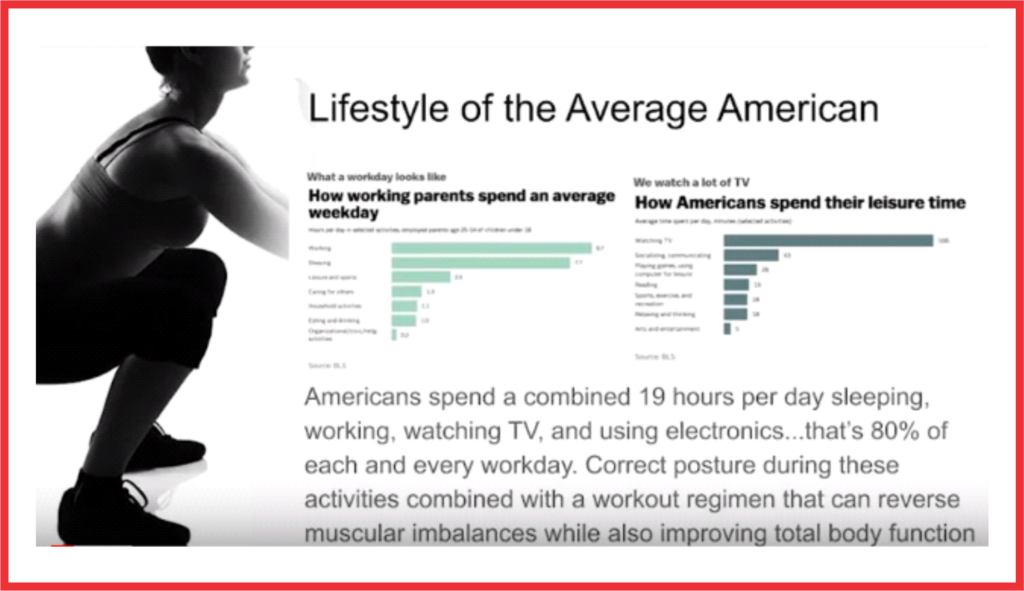
The average American between the ages of 25 and 54 with children under 18 spends 19 hours every day sleeping, working (most of them sitting), watching TV and using electronics (that’s 80% of every day!). The same Americans spend an average of 18 minutes per day in sports, exercise and recreation. (That’s about 1% of every day…)
Most of that sitting, unless you’re very aware of using the correct posture, is spent shoulders slouched with the head down. So, what’s the correct posture, and how do we correct this problem?
Lack of Movement Wreaks Havoc on the Spine
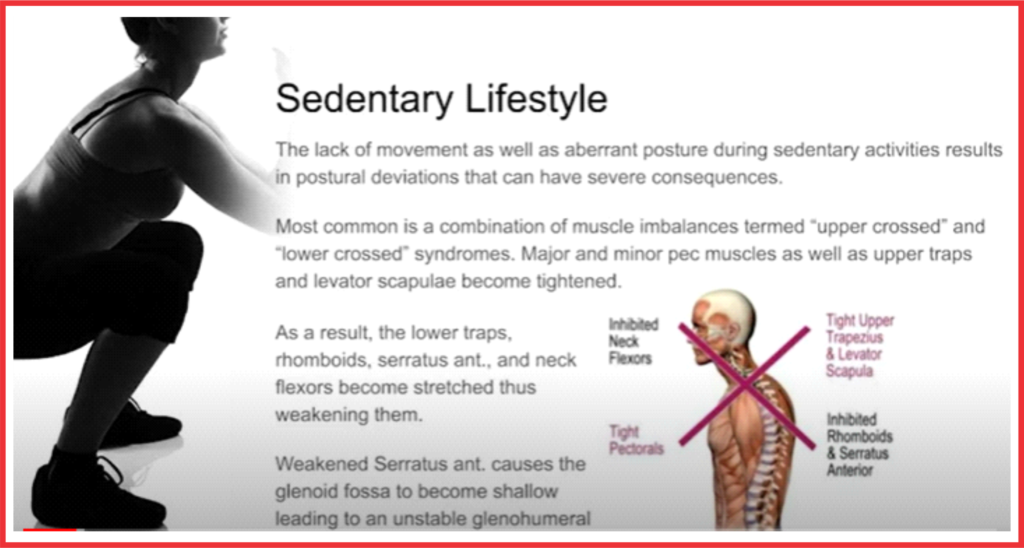
When we sit all day, our necks stretch in the wrong way, we slouch forward, our muscles are not extended to their full length and they become tight. As a result, the muscles that have the opposing action are constantly being stretched – for 80% of the day, each and every day.
Upper and Lower Crossed Syndromes
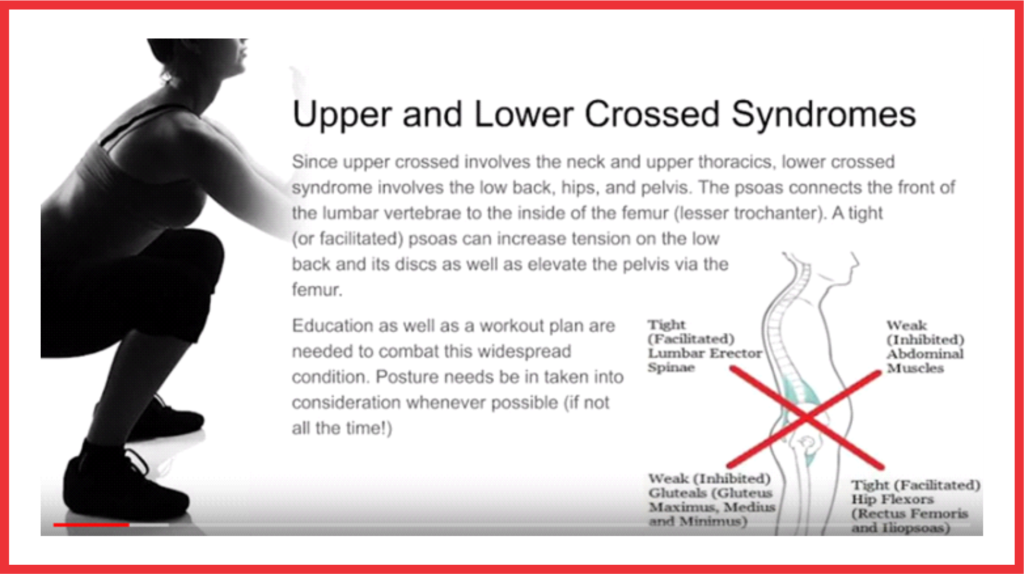
As noted in the above two graphics, two scenarios arise when we are sedentary or sit all day:
- “Upper crossed syndrome†affects the muscles in the neck, shoulders and upper back causing them to tighten
- “Lower crossed syndrome†affects muscles in the lower back, hips and pelvis.
- The psoas muscle connects the front of the lumbar vertebrae to the inside of the femur (the long bone in your thigh). A tightened psoas muscle increases tension on the low back and its discs.
- This also causes weak glutes and weak abdominal muscles.
So, what do we do for all these facilitated and inhibited muscles? We must plan an exercise routine that will counteract that.
Movement is Life

- Both on a microscopic or a macroscopic level, MOVEMENT IS LIFE. Nutrients are transported within the body through many different mechanisms.
- Exercise and movement of skeletal muscles are important for a number of reasons, but arguably the most important are the skeletal muscle pump and venous return of blood to the heart via veins.
- Whether plant or animal, the transaction and transportation of nutrients must occur for life. I believe that one of the most important reasons for movement is the skeletal muscle pump. Let’s think of the heart.
- The heart pumps blood at enormous pressure down through the arteries and into the capillaries. From there the venules pick it up and send it to the veins. Then you need a way for the blood to get back up to the heart, and it takes more than just blood pressure to do it. Movement must be involved.
- For example, the muscles in the calves of your legs must be moved to pump that blood back up to the heart. People who are sedentary often develop varicose veins or “spider†veins. This is due to venous insufficiency from lack of movement.
What is the Kinetic Chain?
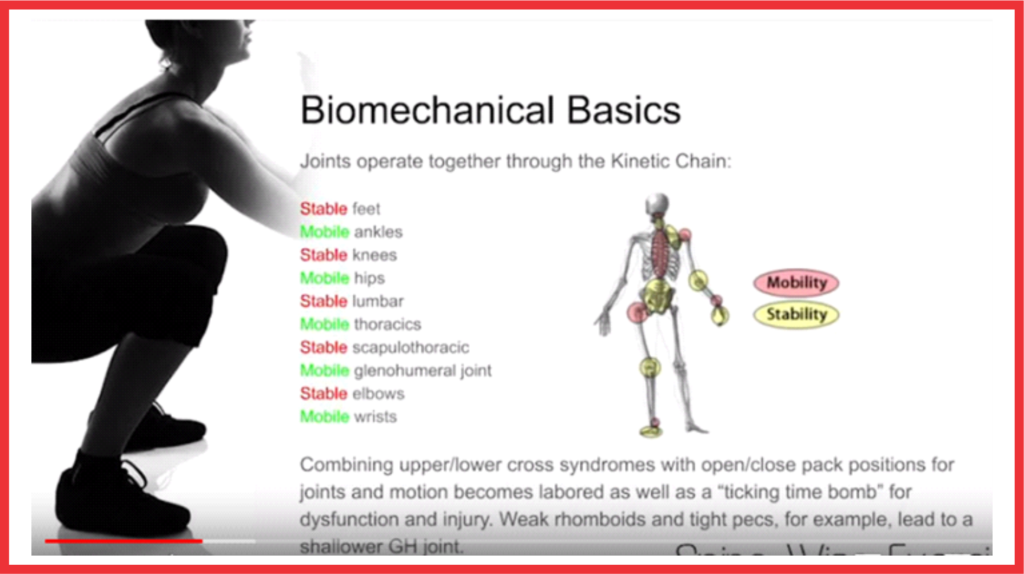
- One of the biomechanical basics is that the joints operate together through the Kinetic Chain. In order, going either up or down the spine, the body has in sequence a stable joint and then a mobile joint. If you have an issue with any point in this “chainâ€, it will likely cause disfunction somewhere else along the chain.
- For example, if you have lack of mobility in the ankle, then the foot will have to compensate for that by over-pronating or turning outward. In turn, the knee will then have more pressure on the middle of the joint causing tight muscles along the thigh. So, unless that ankle problem is addressed, you’re setting yourself up for failure.
Are Most Current Exercise Routines Practical?
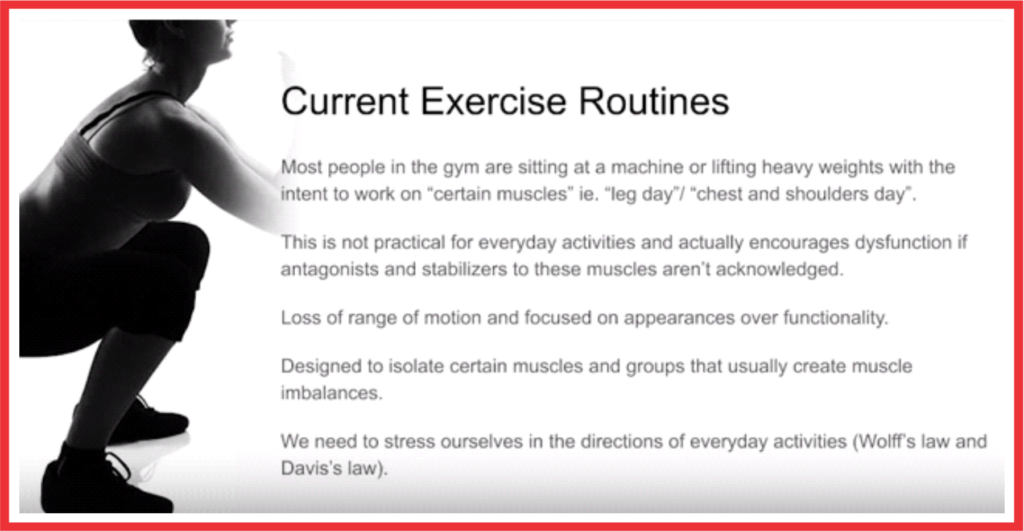
- Most people in the gym are sitting at a machine or lifting heavy weights with the intent to work on “certain musclesâ€, i.e. “leg day†or “chest and shoulders dayâ€.
- This is not practical for everyday activities, and is actually encouraging dysfunction if antagonists and stabilizers to these muscles aren’t acknowledged.
- In doing this, loss of range of motion is inevitable because most people are focused on appearances over functionality.
- This type of exercising isolates certain muscles and groups that usually create muscle imbalances.
- We need to stress ourselves in the directions of everyday activities (Wolff’s Law and Davis’ Law.)
When Faulty Movements Become “Normalâ€
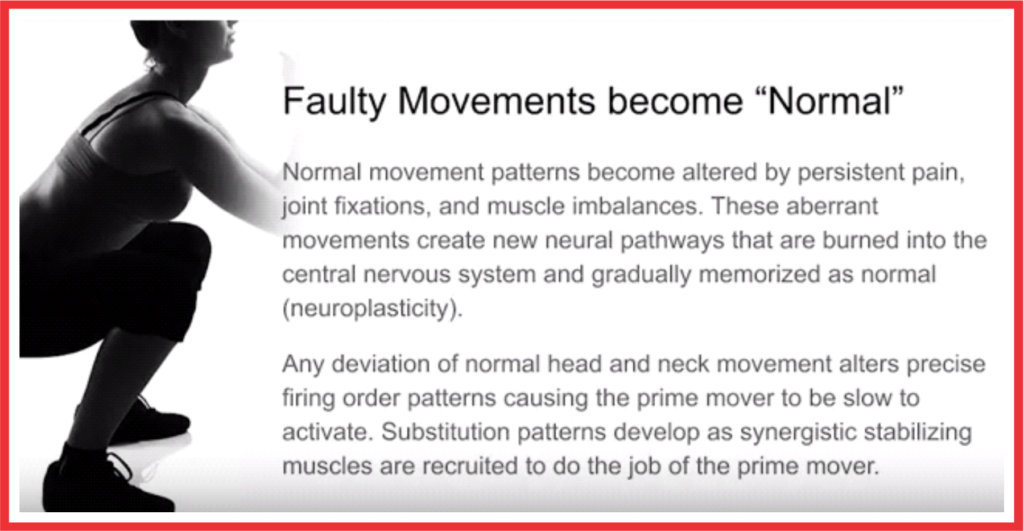
- If you teach your body to do a faulty movement pattern, it will become normal.
- Normal movement patterns become altered by persistent pain, joint fixations and muscle imbalances. These aberrant movements create new neural pathways that are burned into the central nervous system and gradually memorized as normal (neuroplasticity).
- Any deviation of normal head and neck movement alters precise firing order patterns causing the prime mover to be slow to activate. Substitution patterns develop as synergistic stabilizing muscle are recruited to do the job of the prime mover.
What Should Be Our Focus When Exercising?
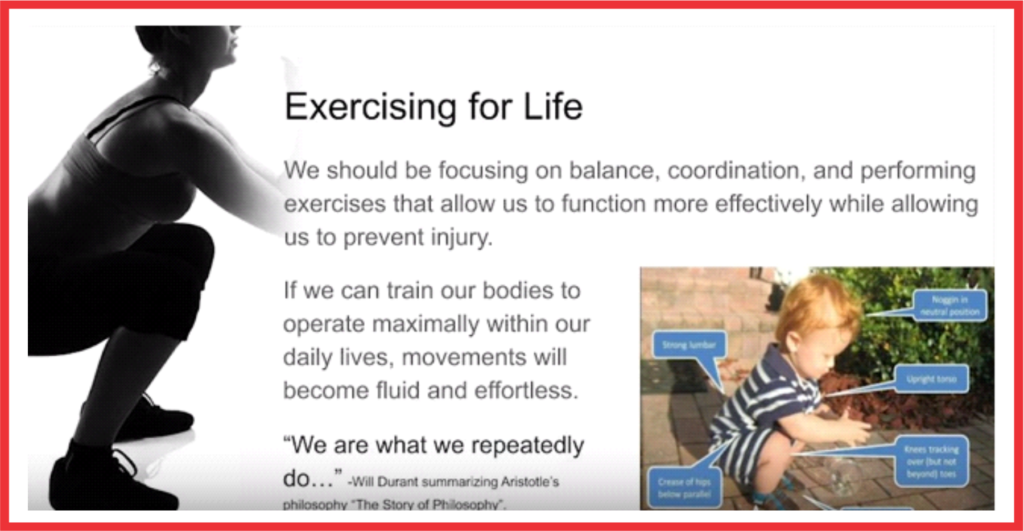
- Our focus should be on balance, coordination and performing exercises that allow is to function more effectively while allowing us to prevent injury.
- If we can train our bodies to operate maximally within our daily lives, movements will become fluid and effortless.
- “We are what we repeatedly do…†– Will Durant summarizing Aristotle’s philosophy. “The Story of Philosophyâ€.
- Notice the baby in the graphic above. He’s naturally squatting in the ideal way – spine straight, head in a neutral position.
Correct posture is crucial!
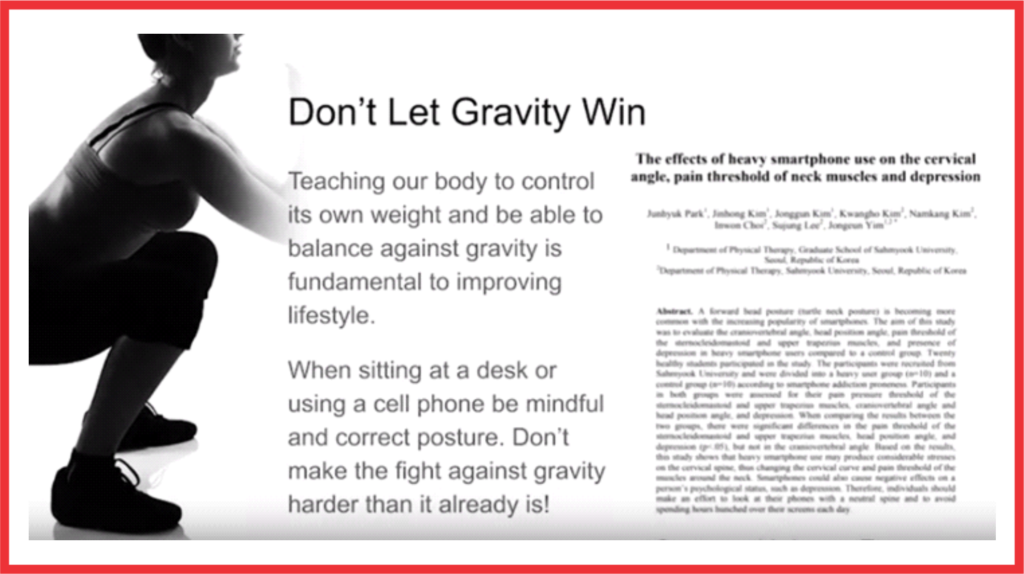
- Sitting slumped over at a desk with forward head posture? You’re letting gravity win the fight for your spinal alignment.
- When we walk with forward head posture, every step we take bounces the spine and creates more forward head posture. As we saw above in the kinetic chain, everything joint connected and contributes to either proper or improper alignment, depending upon our posture.
- A recent small study found that people who had a “cellphone addiction†(constantly looking down at their phones) and used their phones very frequently had increased pain in the muscles of the neck. The study also found that these people had an increase in psychological depression.
- Moral of that story? Hold your cellphone up to look at it!
When you exercise, breathe!
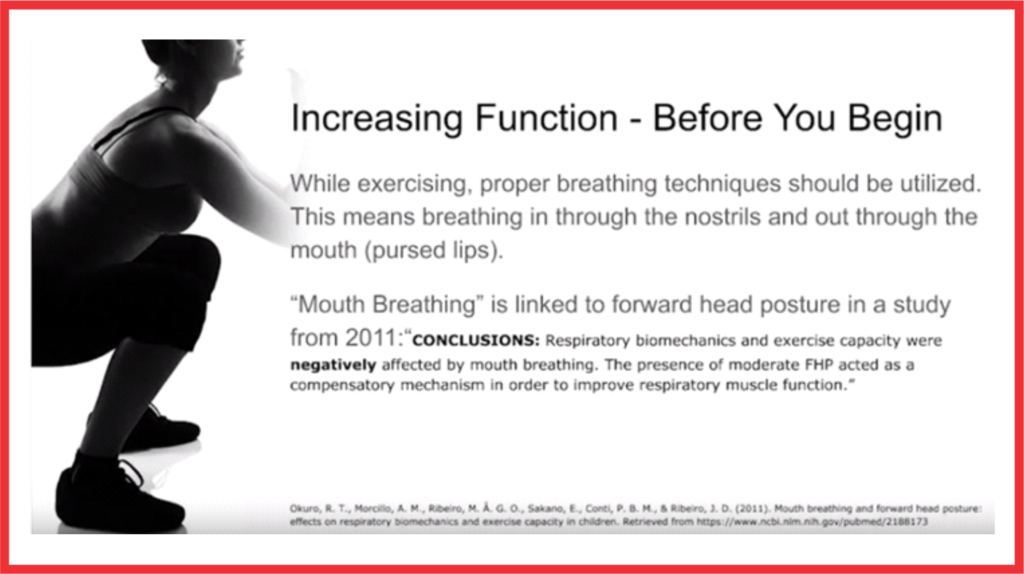
- When exercising, proper breathing means breathing in through the nostrils and out through the mouth with pursed lips.
- A 2011 study showed that mouth breathing negatively affects respiration and exercise capacity.
Improper breathing damages the body
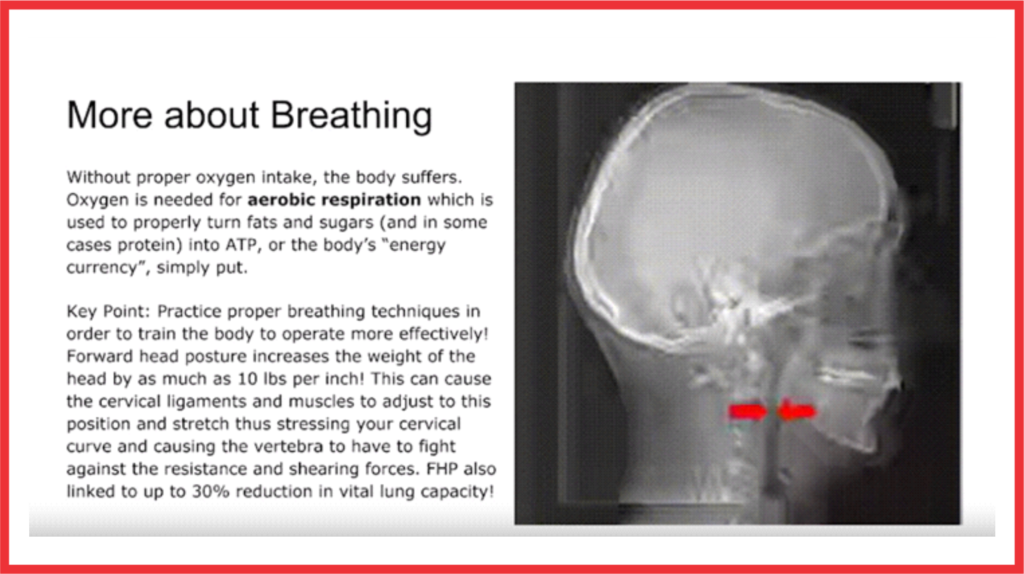
- Improper breathing causes the body to suffer. The body needs proper respiration to turn fats and sugars (and in some cases protein) into ATP – the body’s “energy currencyâ€.
- For every additional inch of forward head posture, the weight of the head increases by 10 pounds! Ligaments and muscles in the neck area then stretch the curve of the spine and reduce lung capacity by up to 30%!
What’s your gym routine?

- Usually, the exercises people do in the gym repeat the same motions over and over, which is good for strengthening certain muscle groups. However, the issue is that this doesn’t focus on using the full range of motion of the muscles.
- For example, most people who can squat 500 pounds on a leg-press usually can’t perform a one-legged squat because of weak stabilizing muscles in their legs and loss of range of motion in their hips and ankles. Nothing against squats…just be sure to do stabilizing exercises as well!
Let’s talk about sit-ups and squats…
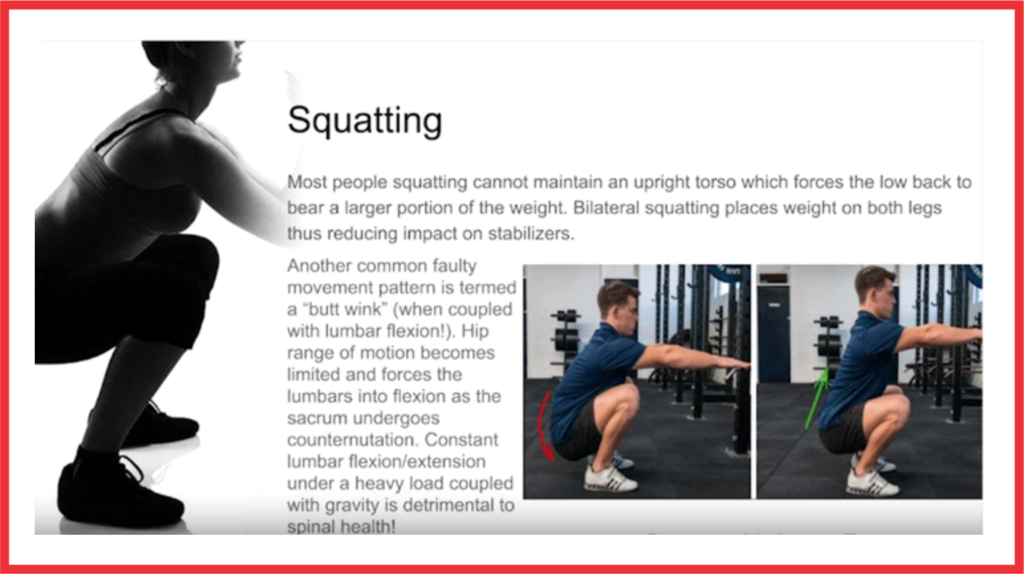
- Studies show that sit-ups show no effect on abdominal fat. Sit-ups and crunches cause a shearing force on the lumbar discs and worsen disc degeneration. They also over-stress the psoas muscle which is usually already over facilitated.
- The U.S. Army is phasing out sit-ups from the Army Physical Fitness Test because “they can be harmful and there are better ways of strengthening the coreâ€.
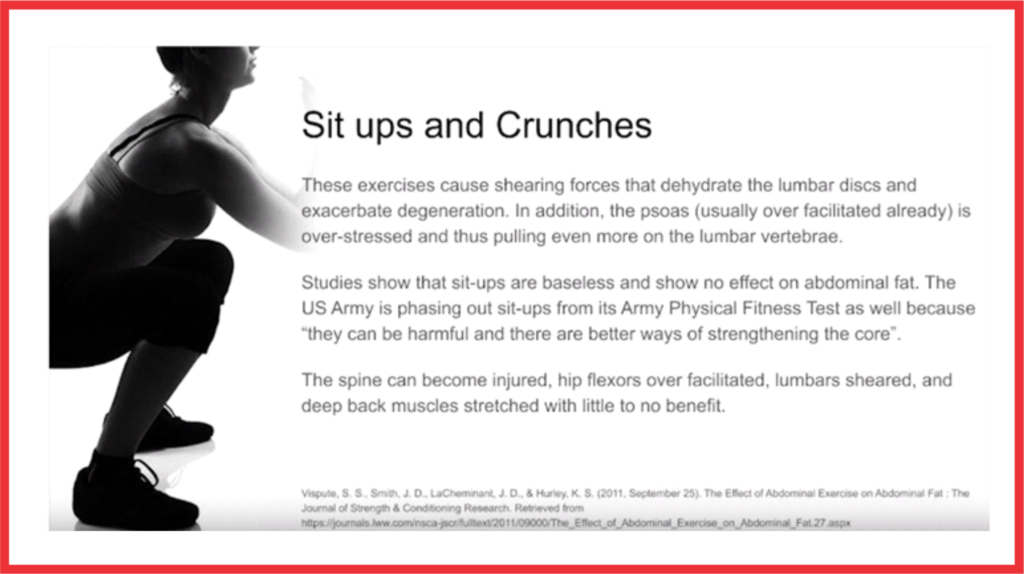
- When doing squats and you get too low (as in the left inset picture above), a “butt wink†occurs. This limits the hips’ range of motion, forces lumbar muscles into flexion and causes counternutation of the sacrum.
- Always keep the back and torso upright and keep the head in a neutral position when doing squats. Done in this way, squats are an excellent exercise for core strength and overall functional fitness. They can provide greater hip range of motion as well as lumbar stability while strengthening the core.
- Functional Movement Systems has a grading system which has 4 ratings for your movement in performing a squat. It explains in detail how to do a proper squat with illustrations.
Beginning a Workout Plan
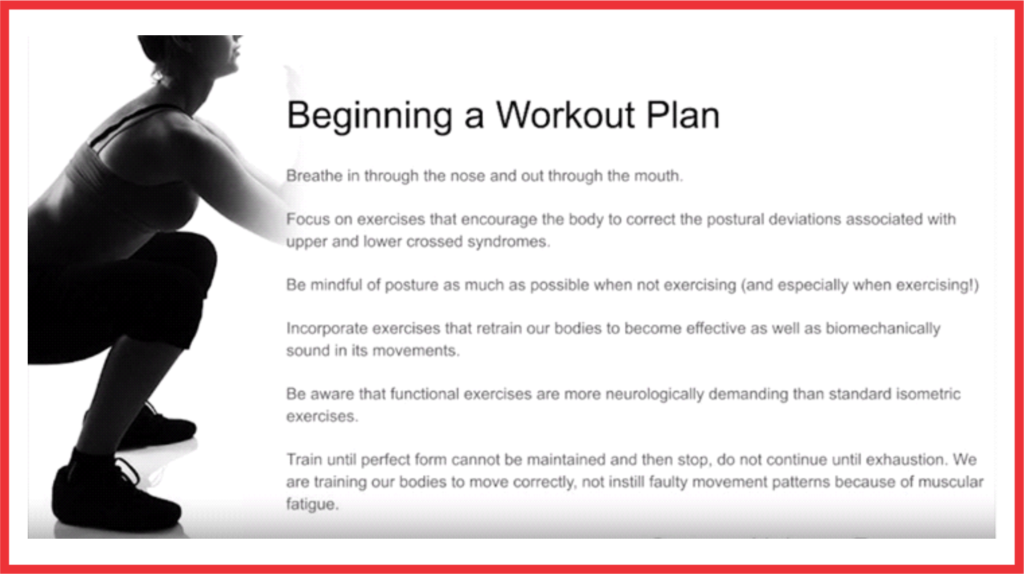
- Breathe in through the nose and out through the mouth
- Focus on exercises to correct bad posture associated with upper and lower crossed syndromes
- Be mindful of your posture, both when exercising and when you’re not!
- Incorporate exercises that retrain the body to become effective and biomechanically sound in its movements.
- Be aware that functional exercises are more neurologically demanding than standard isometric exercises.
- You should train until you cannot maintain perfect form, then stop…do not continue until exhaustion. We are training our bodies to move correctly, not to instill faulty movement patterns because of muscular fatigue.
Correcting Upper Crossed Syndrome
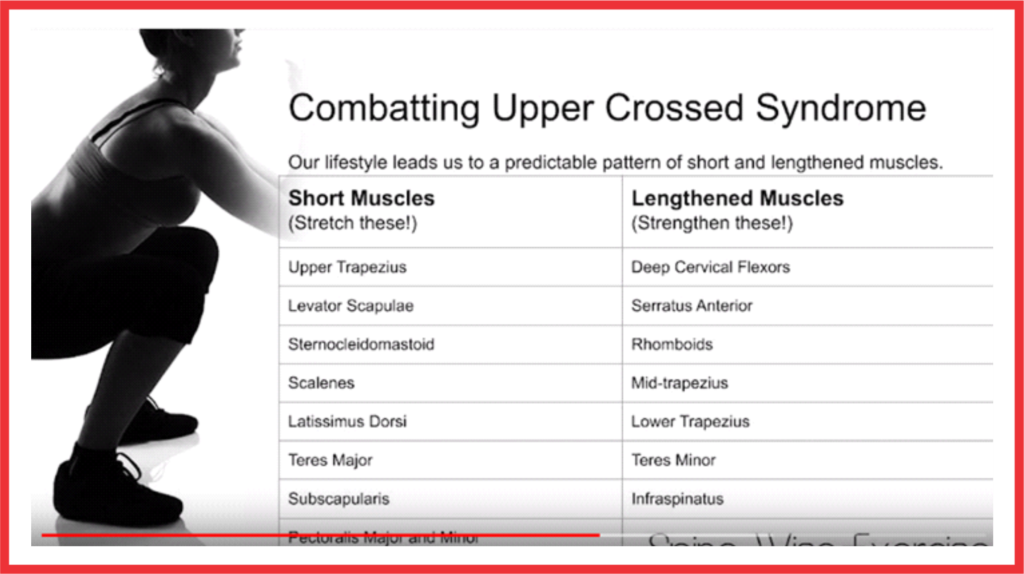
- The way we live leads to a predictable pattern of short and lengthened muscles. We need to stretch shortened muscles and strengthen the lengthened ones. For instance, if we sit at a desk all day with forward head posture, then we need to concentrate on reversing the improper positioning of the neck and associated muscles. Keep the head and shoulders pulled back.
- Do stretches against resistance with relaxation cycles (PIR stretching).
- Exercises for rhomboids and stretching pecs are simple to do. Keep posture in mind constantly.
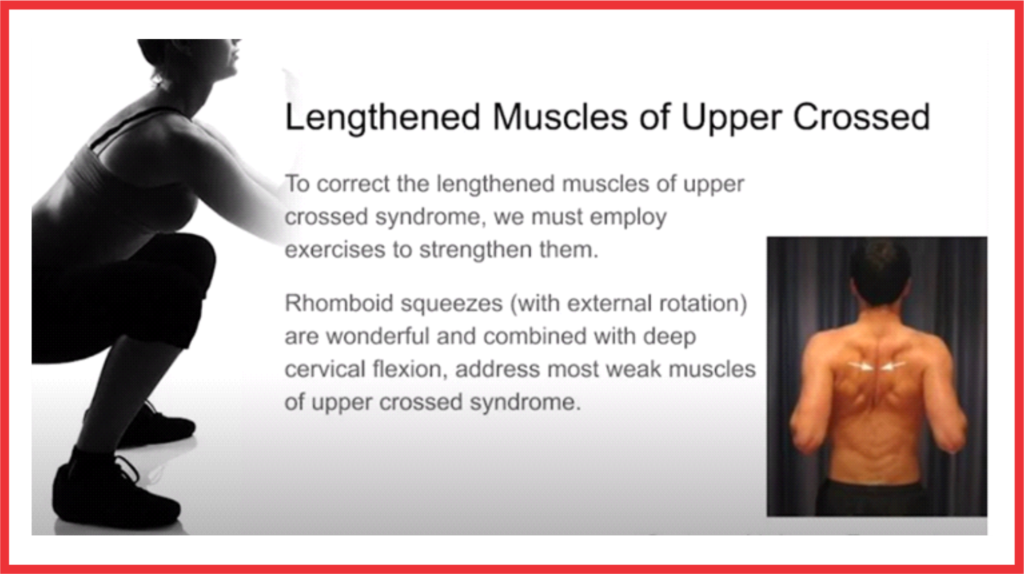
- After stretching for 15 minutes a day, the next step is to lengthen the muscles.
- Besides always keeping good head posture, try this: With your head straight and looking ahead, move the head backward on your neck (looks like you have a double chin) and pretend you have balloons on top of your head pulling it up. Not flattering, but effective!
- The rhomboid squeeze as seen in the picture above is very helpful in stretching to correct upper crossed syndrome.
Correcting Lower Crossed Syndrome
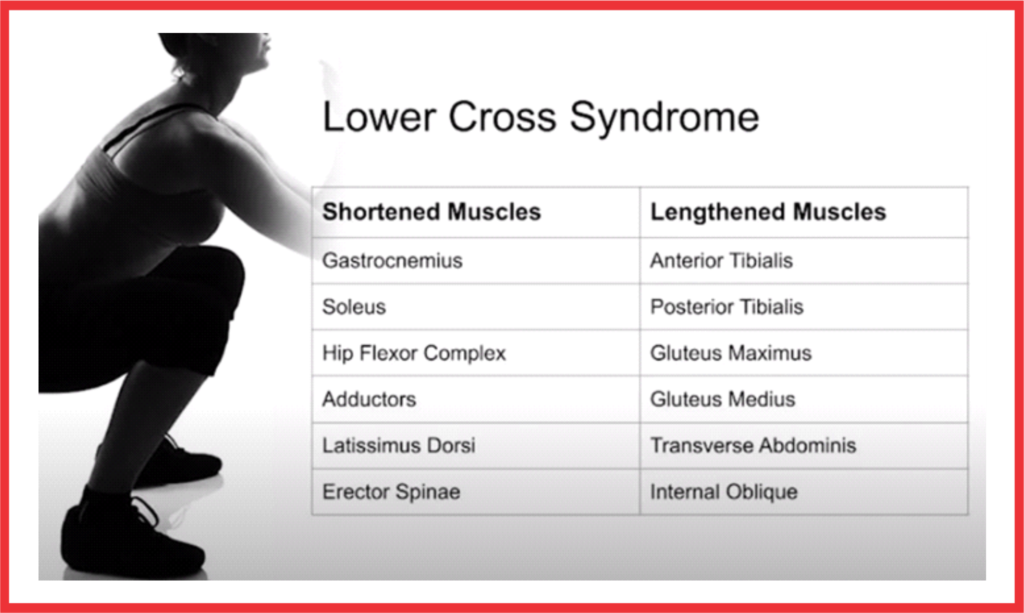
Stretching Tightened Muscles

Here are five stretches that are effective in stretching and balancing the muscles in Lower Cross Syndrome:
- Brugger’s stretch: Sitting tall with chin tucked back, lift chest and externally rotate arms back.
- Chin Tuck: Tuck chin straight back and hold for several seconds.
- Forward Lunge: With hands on hips and torso tall, lean forward to feel a stretch in the psoas.
- Pectoralis Stretch: Staying tall, rotate shoulders and extend arms back.
- Quadriceps Stretch: Lift the leg from behind with both arms as shown in the picture above and hold for a few seconds.
Strengthening Weak Muscles
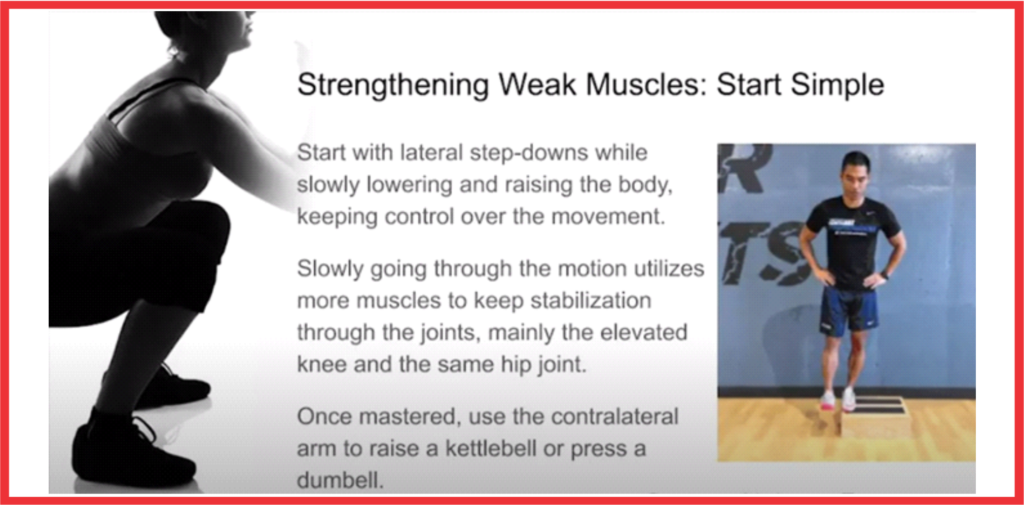
Lateral step-downs: Standing on one foot on a stable raised surface, slowly lower the other foot down and back up without touching the floor, keeping control over the movement.
Combating Lower Crossed Syndrome
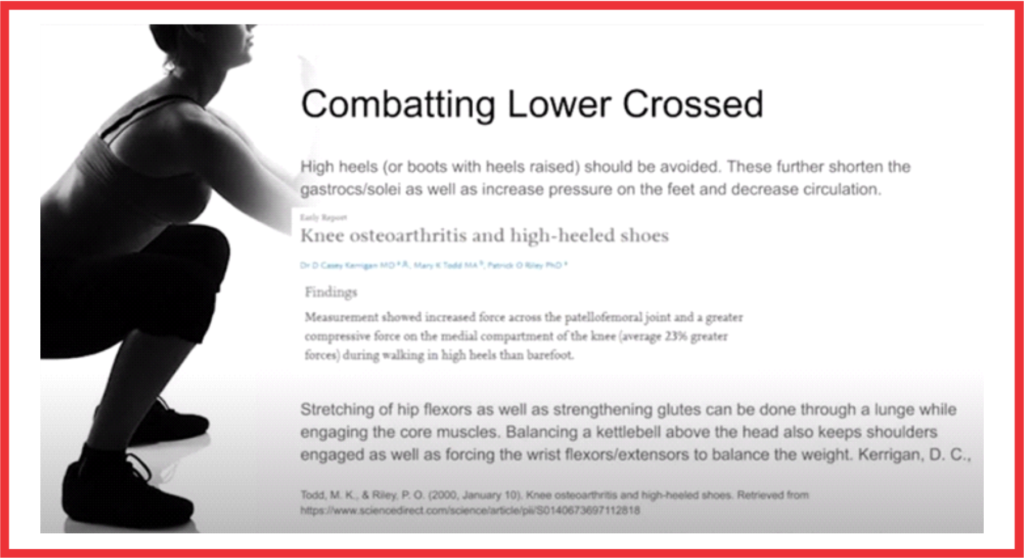
High heels for women, or boots with raised heels for men, should be avoided. Why? They:
- Shorten and weaken the muscles in the lower leg
- Put more pressure on the feet
- Decrease circulation
- Can cause osteoarthritis in the knee
Doing lunges while engaging core muscles stretches the hip flexors and strengthens the glutes.
Exercises for Lower Crossed Syndrome
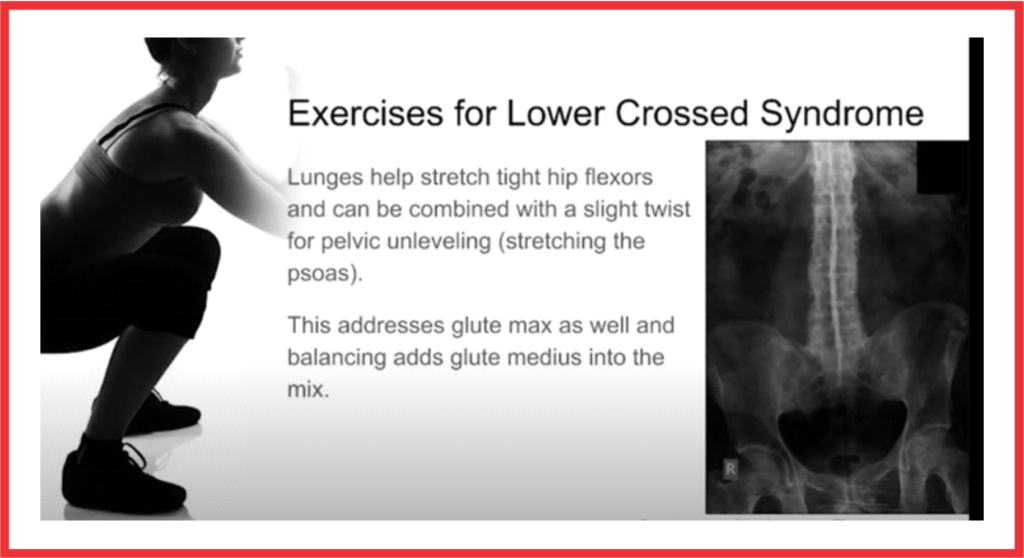
Stretching the hip flexors can be done through lunges and can be combined with a slight twist for an unlevel pelvis. This stretches the psoas muscle. It also addresses gluteus maximus as well and balancing adds gluteus medius into the mix.
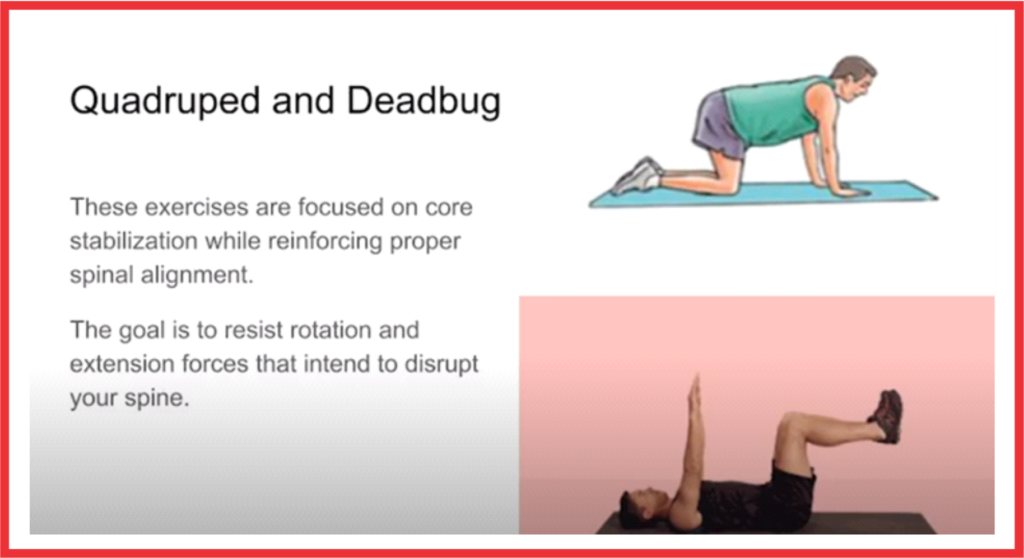
Quadruped: While on hands and knees:
- Extend right leg back and up wile extending the left arm out in front of you
- Repeat with the left leg and the right arm
Deadbug: Lying on your back with legs bent up parallel to the floor and arms stretched upward:
- Alternate lowering right leg down to the floor and left arm over the shoulder to the floor
- Repeat with the left leg and right arm
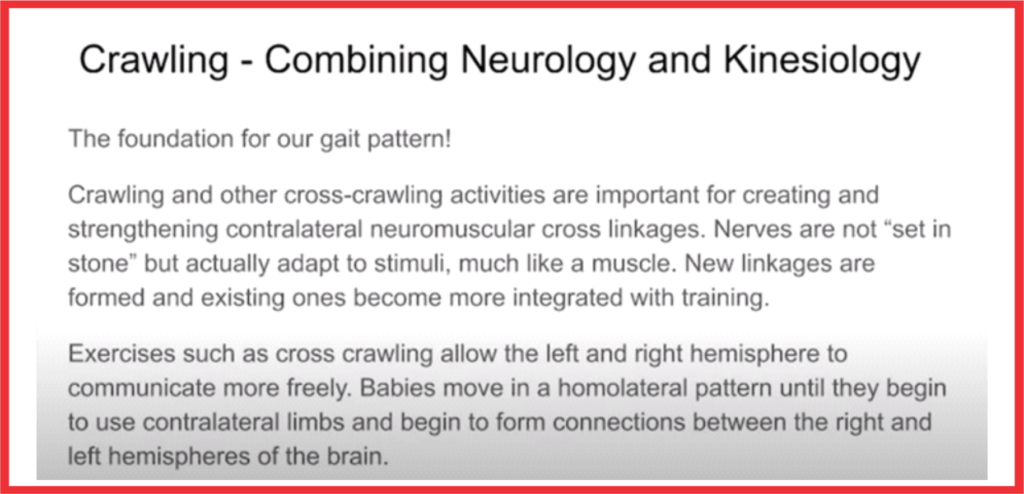
Crawling is the foundation for our gait pattern – look at babies!
- Crawling is important for creating and strengthening contralateral neuromuscular cross-linkages.
- Nerves are not “set in stoneâ€, but adapt to stimuli as does a muscle. Crawling helps new linkages to form and existing ones to become more integrated with training.
- Also, crawling allows the right and left brain hemispheres to communicate more freely. Babies first move by using the arm and leg on the same side (homolateral), then they use opposing limbs and form connections between right and left brain hemispheres, telling them to work together.
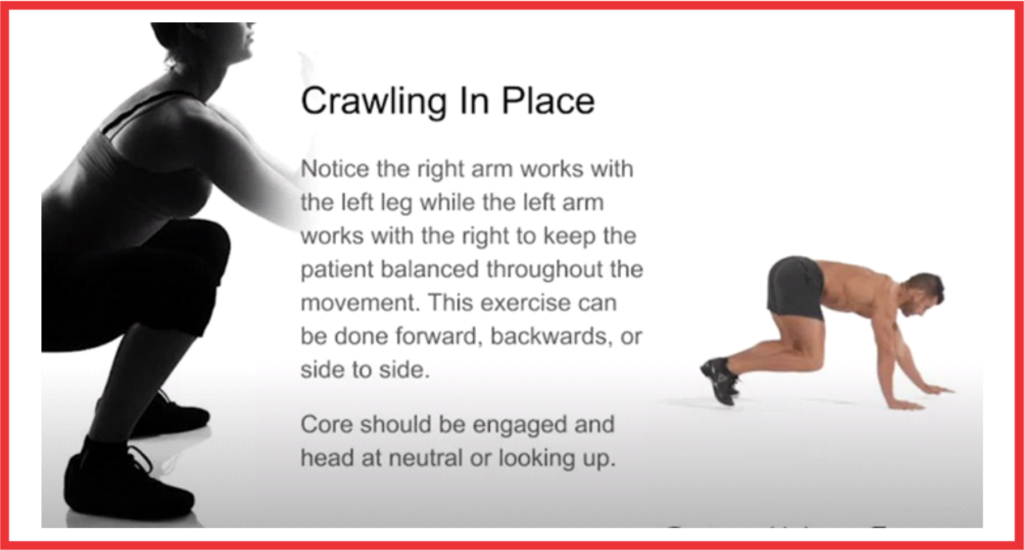
Important Things to Remember
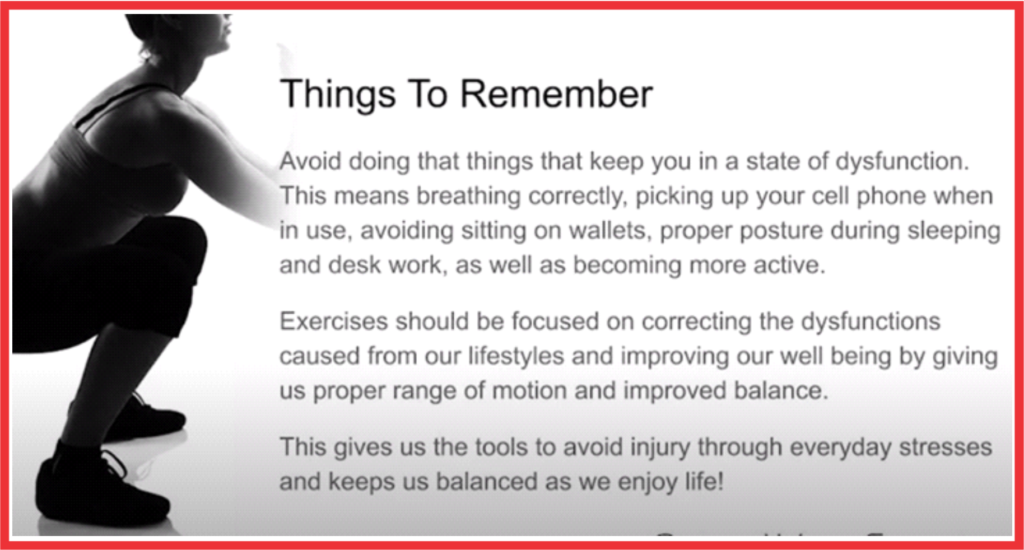
Don’t continue in a state of dysfunction! Always try to:
- Breathe correctly
- Pick up your cell phone while using it
- Avoid sitting on your wallet
- Avoid high heels or boots with raised heels
- When you work and sleep, maintain good posture
- Become more active
Exercises should be focused on correcting the dysfunctions caused from our lifestyles so that our well-being, range of motion and balance are improved. Then we have the tools to help us avoid injury from everyday stresses and stay balanced as we enjoy life!
Any Questions?
There is always new research forthcoming in the fields of kinesthetics and physiology. Some great references:
FMS @ https://www.functionalmovement.com/
Tim Anderson @ https://originalstrength.net/
Heidi Haavik @ http://www.heidihaavik.com/
